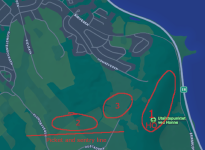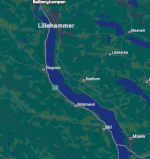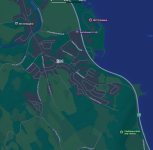So huddle with my platoon commanders.
Clearly we want to hold that ridge, and the map even
tells us where a good spotting position is. The ridge completely dominates the main road by the side of the lake. Once we get things sorted, we can hold that against three times our numbers. But we also can't really find good positions in the darkness, so we will have to improvise tonight, and then sort things out tomorrow.
1st Platoon, establish a spotting and firing position at and around the overlook point, making sure you have eyes on the road. I will join you there with the company HQ, so we will have the additional weapons there, including the Vickers and the AT rifles. With any luck, there's an actual path up to that overlook point, maybe even signs. We will set up the Vickers to point at the road with a good field of fire in general.
2nd Platoon, establish a picket line that covers both smaller roads coming up from the south. Deploy sentries ahead of your positions. Don't be afraid of falling back if the enemy runs into you in numbers. We'll have to get a better look on this tomorrow.
3rd Platoon, establish a reserve between and behind 1st and 2nd Platoons' positions. Make sure you know a path up to the overlook position. Let your men have some sleep, just the regular sentries.
You can be relaxed about light discipline while you find your positions - I don't want any broken legs here - but start maintaining it once you're there. No-one smokes while on watch!
1st and 2nd, let everyone have a little sleep at least - make it two watches until dawn. Tea to help keep the men warm and up.
If it becomes necessary, the fallback and rally point is up on the ridge.
We'll have a new look at this in the morning. Questions?




